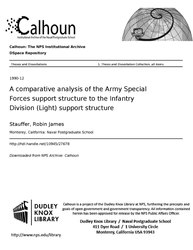File:A comparative analysis of the Army Special Forces support structure to the Infantry Division (Light) support structure (IA acomparativenaly1094527678).pdf

Original file (1,275 × 1,650 pixels, file size: 4 MB, MIME type: application/pdf, 130 pages)
Captions
Captions
Summary[edit]
| A comparative analysis of the Army Special Forces support structure to the Infantry Division (Light) support structure
( |
||
|---|---|---|
| Author |
Stauffer, Robin James |
|
| Title |
A comparative analysis of the Army Special Forces support structure to the Infantry Division (Light) support structure |
|
| Publisher |
Monterey, California: Naval Postgraduate School |
|
| Description |
The problem examined in this thesis is whether the current structure for the command and control of combat service support for Army special operations forces (ARSOF) is adequate for all ARSOF support units. This thesis is focused on the internal sustainment of ARSOF during contingency operations. The objective of this thesis is to conduct a comparative analysis of three alternative ARSOF support command and control structures to the support structure for the infantry division (light) to determine if the current ARSOF support command and control structure can be improved. The three ARSOF alternatives are: (1) the current ARSOF support organization, (2) the proposal by the U.S. Army Special Warfare Center and School and the U.S. Army Infantry Center to create a special operations support unit and a ranger support battalion, and (3) the author's proposal to create a special operations support command (SOSCOM). The analysis is based on the following measures of effectiveness (MOEs) for an efficient planning support structure: (1) tooth-to- tail ratio, (2) the number of support planning nodeschannels, (3) the proximity of support planning nodes to each other, and (4) the number of organic and nonorganic support units. Subjects: ARSOF; Army Special Operations Forces; CSS; Combat Services Support; Infantry; Logistics; SOSCOM; Special Operations Support Command |
|
| Language | English | |
| Publication date |
December 1990 publication_date QS:P577,+1990-12-00T00:00:00Z/10 |
|
| Current location |
IA Collections: navalpostgraduateschoollibrary; fedlink |
|
| Accession number |
acomparativenaly1094527678 |
|
| Source | ||
| Permission (Reusing this file) |
This publication is a work of the U.S. Government as defined in Title 17, United States Code, Section 101. As such, it is in the public domain, and under the provisions of Title 17, United States Code, Section 105, may not be copyrighted. | |
Licensing[edit]
| Public domainPublic domainfalsefalse |
This work is in the public domain in the United States because it is a work prepared by an officer or employee of the United States Government as part of that person’s official duties under the terms of Title 17, Chapter 1, Section 105 of the US Code.
Note: This only applies to original works of the Federal Government and not to the work of any individual U.S. state, territory, commonwealth, county, municipality, or any other subdivision. This template also does not apply to postage stamp designs published by the United States Postal Service since 1978. (See § 313.6(C)(1) of Compendium of U.S. Copyright Office Practices). It also does not apply to certain US coins; see The US Mint Terms of Use.
|
 | |
| This file has been identified as being free of known restrictions under copyright law, including all related and neighboring rights. | ||
https://creativecommons.org/publicdomain/mark/1.0/PDMCreative Commons Public Domain Mark 1.0falsefalse
File history
Click on a date/time to view the file as it appeared at that time.
| Date/Time | Thumbnail | Dimensions | User | Comment | |
|---|---|---|---|---|---|
| current | 06:46, 8 July 2020 |  | 1,275 × 1,650, 130 pages (4 MB) | Fæ (talk | contribs) | FEDLINK - United States Federal Collection acomparativenaly1094527678 (User talk:Fæ/IA books#Fork8) (batch 1990-1992 #2795) |
You cannot overwrite this file.
File usage on Commons
The following page uses this file:
Metadata
This file contains additional information such as Exif metadata which may have been added by the digital camera, scanner, or software program used to create or digitize it. If the file has been modified from its original state, some details such as the timestamp may not fully reflect those of the original file. The timestamp is only as accurate as the clock in the camera, and it may be completely wrong.
| Short title | A comparative analysis of the Army Special Forces support structure to the Infantry Division (Light) support structure |
|---|---|
| Author | Stauffer, Robin James |
| File change date and time | 05:44, 24 January 2012 |
| Date and time of digitizing | 05:44, 24 January 2012 |
| Date metadata was last modified | 05:44, 24 January 2012 |
| Software used | Stauffer, Robin James |
| Conversion program | |
| Encrypted | no |
| Page size |
|
| Version of PDF format | 1.4 |

